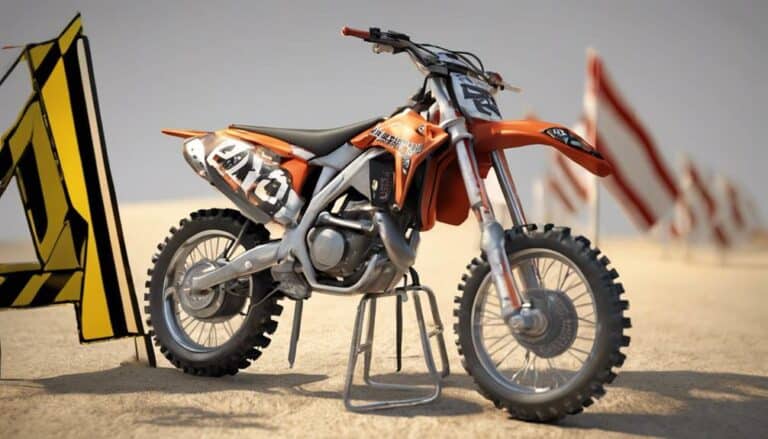When venturing into the domain of dirt bike jumping, think of safety precautions as crucial as a compass in the wilderness. Every beginner should approach this adrenaline-pumping activity with caution and respect for the risks involved. Starting with the basics of safety gear is just the tip of the iceberg.
But what about the track conditions and mental preparedness needed to conquer those jumps? Stay tuned to discover the complete safety measures essential for beginners to thrive in the exhilarating world of dirt bike jumping.
Key Takeaways
- Wear full safety gear including a helmet, pants, chest pads, neck brace, and knee braces.
- Inspect the track for obstacles, debris, and proper jump conditions before practicing jumps.
- Focus on proper jump execution techniques like throttle control and smooth landings.
- Start with small jumps, master basic techniques, and progress gradually to more complex jumps.
Safety Gear and Equipment
When preparing for dirt bike jumps, it is crucial to have the essential safety gear and equipment to protect yourself from potential injuries. Beginners should prioritize safety by wearing the necessary protective equipment, such as a full-face helmet, riding pants, chest pads, neck brace, and knee braces. These items are essential for the best safety during dirt bike jumps.
Investing in high-quality safety gear enhances rider safety and reduces the risk of accidents. Safety gear like knee braces and chest pads provide added protection for vulnerable areas during jumps. It is essential to select the proper safety gear to protect against potential injuries while practicing jumps.
Track Inspection and Preparation
Inspect the track thoroughly for obstacles, debris, and proper jump conditions before attempting any jumps. Make sure the jump faces are clear and free of obstructions to prevent accidents during practice.
Check the landing areas for smoothness, stability, and visibility to plan your landings effectively. Be on the lookout for track markers, signage, and safety barriers to help you stay within designated riding areas.
Familiarize yourself with the track layout, jump distances, and potential hazards to navigate safely during practice sessions. Remove any obstacles or debris that could pose a risk to your safety.
Guarantee that safety barriers are intact and positioned correctly to protect you in case of a fall. By preparing the track properly, you can enhance your overall dirt bike jumping experience and reduce the likelihood of accidents or injuries.
Always prioritize safety when inspecting and preparing the track for your practice sessions.
Proper Jump Execution Techniques
To achieve successful dirt bike jumps, focus on maintaining a centered body position with your feet on the foot pegs and your knees bent for stability. When executing dirt bike jumps, remember the following key techniques:
- Throttle Control: Use proper throttle control to avoid sudden acceleration or wheelies while approaching and leaving the jump.
- Smooth Landings: Focus on smooth and controlled landings by absorbing impact with your knees and applying throttle upon landing.
- Practice Jumps: Start with safe jumps like singles or tabletops to build confidence and avoid risky jumps as a beginner.
Landing Strategies for Beginners
For beginners looking to enhance their dirt bike jumping skills, mastering effective landing strategies is essential for safe and successful rides. When landing a dirt bike jump, it's important to maintain control and stability. Here are some key landing strategies for beginners to keep in mind:
| Landing Strategy | Description | Tips |
|---|---|---|
| Position | Adjust body position to control landing angles | Keep your body balanced and centered |
| Throttle | Keep the throttle on to maintain forward momentum | Control your speed upon landing |
| Front Wheel First | Focus on landing the front wheel first for stability | Ensure a smooth and stable landing |
| Rear Wheel First | Land rear wheel first on flat jumps | Absorb impact with your knees |
Progression and Practice Plan
When progressing in your dirt bike jumping skills, developing a structured practice plan is essential for enhancing your abilities over time.
Here are three key points to ponder when creating your practice plan:
- Start Small, Build Confidence: Begin practicing on small jumps to gradually build your confidence and skills before moving on to more advanced jumps.
- Master the Basics: Focus on mastering basic jumping techniques such as proper body positioning and throttle control before attempting complex jumps.
- Consistent Practice: Develop a consistent practice schedule to improve your jumping abilities over time. Repetition and dedication are key to progress steadily.
Conclusion
As you soar through the air on your dirt bike, remember that safety is your wings, guiding you to new heights. Just like a bird needs its feathers to fly, you need your protective gear to stay safe and enjoy the thrill of jumping.
So, suit up, inspect your track, master your techniques, and land smoothly like a graceful bird returning to its nest. Embrace the freedom of flight, knowing you're prepared for any adventure that comes your way.

